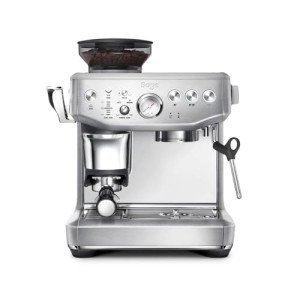Heat Exchange Espresso Machines: A Comprehensive Guide
Espresso machines have progressed considerably for many years, dealing with the needs of home baristas and coffee professionals alike. Among Espresso Machines Under £200 , heat exchange espresso machines have actually gained appeal due to their ability to deliver consistent efficiency and extraordinary brew quality. In this post, we will explore the functions, benefits, and essential functions of heat exchange espresso machines, offering a comprehensive understanding for both prospective buyers and coffee enthusiasts.
Comprehending Heat Exchange Technology
Heat exchange espresso machines operate on a special concept that permits simultaneous water heating for brewing and steaming. They are equipped with a single boiler that uses a heat exchanger system. This function is considerable as it enables users to brew espresso while steaming milk concurrently, promoting effectiveness in the coffee-making process.
How Does a Heat Exchange Espresso Machine Work?
The procedure starts with the machine's water inlet filling the boiler. As the water warms up, it turns to steam. The innovative heat exchanger uses hot steam to heat additional water in a separate passage developed particularly for the brew group. This suggests that water can reach the perfect brewing temperature level without awaiting the boiler to adjust. The crucial actions consist of:
- Water Fill: Water is drawn into the boiler.
- Heating Process: The boiler warms up as water is converted into steam.
- Heat Exchange: Steam heats up water in the heat exchanger tube.
- Brewing: Water from the heat exchanger is pressed through coffee premises, extracting the tastes required for an abundant espresso.
This process enables for quick temperature modifications and improved coffee extraction.
Advantages of Heat Exchange Espresso Machines
Heat exchange espresso machines offer a number of benefits, especially for those seeking to maximize their coffee experience. Here are some crucial benefits:
- Simultaneous Brewing and Steaming: Users can brew espresso while steaming milk, making it ideal for busy coffee shops and home baristas who value efficiency.
- Temperature level Stability: The boiler's steam pressure helps keep a steady temperature, which is critical for constant espresso extraction.
- Versatility: The design permits for quick changing in between developing and steaming, making it simpler to produce different coffee beverages, from lattes to cappuccinos.
- User-friendly: Models frequently feature available controls, making it practical for both beginners and knowledgeable baristas to produce quality drinks.
- Professional Quality: Heat exchange machines are often utilized in commercial settings, offering users with high-quality brewing performance in your home.
Key Features to Look for in Heat Exchange Espresso Machines
When considering the purchase of a heat exchange espresso machine, there are a number of features that a person ought to take into consideration:
- Build Quality: Look for machines made from long lasting materials, such as stainless steel or brass, making sure durability.
- Boiler Size: A larger boiler will hold more water and sustain higher output over time.
- PID Temperature Control: This feature helps preserve consistent brew temperature levels, which can improve the coffee-making procedure.
- Group Head Design: Machines with a saturated or semi-saturated group head supply much better temperature level stability.
- Ease of Use: User-friendly user interfaces and instinctive controls improve the general experience for baristas at all skill levels.
- Steam Wand Quality: A good steam wand with appropriate insulation and versatility permits better texturing of milk.
- Water Reservoir Size: Depending on your requirements, think about how often you wish to fill up the water tank.
Comparison of Popular Heat Exchange Espresso Machines
To better comprehend the choices offered in the market, listed below is a contrast table of some popular heat exchange espresso machines:
| Machine Model | Boiler Size | PID Control | Price Range | User Ratings |
|---|---|---|---|---|
| Profitec Pro 700 | 2.0 L | Yes | ₤ 2,000-₤ 2,500 | 9.5/ 10 |
| Rocket Espresso R58 | 1.8 L | Yes | ₤ 2,400-₤ 2,800 | 9.4/ 10 |
| Elekta Bianca | 1.8 L | Yes | ₤ 2,500-₤ 3,000 | 9.6/ 10 |
| La Spaziale S1 Vivaldi II | 1.5 L | Yes | ₤ 1,800-₤ 2,200 | 9.2/ 10 |
| Bezzera Magica | 1.2 L | No | ₤ 1,600-₤ 1,800 | 9.0/ 10 |
FAQs About Heat Exchange Espresso Machines
What is the primary distinction between a heat exchange and a dual boiler espresso machine?
While both types can brew espresso and steam milk at the exact same time, dual boiler machines have different boilers for brewing and steaming. On the other hand, heat exchange machines use a single boiler and a heat exchanger to accomplish the very same function.
Are heat exchange machines ideal for beginners?
Yes! Buy Espresso Online are created with user-friendly functions, making them accessible for newbies. With correct assistance and practice, users can quickly produce quality espresso.
What sort of maintenance do heat exchange espresso machines need?
Regular upkeep includes descaling, cleaning up the boiler, inspecting seals and gaskets, and keeping the group head tidy. Routine upkeep ensures durability and consistent performance.
Can I use a heat exchange machine for various kinds of coffee drinks?
Absolutely! Heat exchange machines enable users to create a variety of coffee beverages, consisting of espresso, lattes, coffees, and more.
Heat exchange espresso machines represent a mix of development and custom, supplying coffee lovers with the tools needed for crafting the best cup. Their ability to simultaneously brew and steam, combined with accurate temperature level control, makes them an engaging option for both home baristas and professionals. With the ideal understanding on functions and upkeep, users can open a world of elegant coffee experiences, ensuring that each sip is as wonderful as the last.

